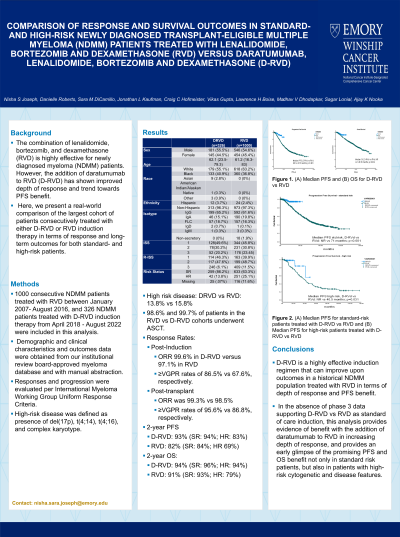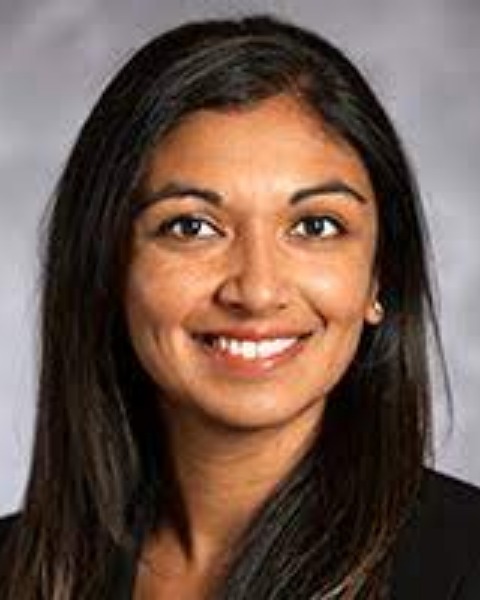Treatment of Newly Diagnosed Myeloma - Transplant Eligible
Poster Session 1
P-141: Response and survival outcomes of daratumumab, lenalidomide, bortezomib and dexamethasone (D-RVD) induction in transplant-eligible newly diagnosed multiple myeloma (NDMM) patients
Wednesday, September 27, 2023
1:30 PM - 2:30 PM EEST


Nisha S. Joseph, MD
Assistant Professor
Winship Cancer Institute at Emory University, Atlanta, GA, USA
Atlanta, Georgia, United States
Introduction: The combination of lenalidomide, bortezomib, and dexamethasone (RVD) has been shown to be highly effective for both transplantation-eligible and -ineligible patients with newly diagnosed myeloma (NDMM). More recently, the addition of daratumumab (D) to RVd (D-RVd) in transplant-eligible NDMM patients was evaluated in the GRIFFIN trial (Voorhees et al) showing that sCR rates improved for D-RVd vs RVd. We present the largest cohort of patients consecutively treated with D-RVd induction therapy and the impact of D-RVd on long-term outcomes.
Methods: 326 consecutive patients with newly diagnosed myeloma treated with D-RVd induction therapy from April 2018 until August 2022 were included in this analysis. Demographic and clinical characteristics and outcomes data were obtained from our institutional review board-approved myeloma database, and manual extraction. Responses and progression were evaluated per International Myeloma Working Group Uniform Response Criteria.
Results: The cohort consisted of 181 (55.5%) males, 133 (41%) black. The median age was 64.3 (23.5-79.3) vs 59 (34.7-76.7) years, p< 0.05 for whites vs. black, respectively. 199 (65.2%) had IgG isotype, 64 (21.4%) had t(11;14), 17 (5.2%) had del 17p, 13 (4%) had t(4;14) 3 (1%) had t(14;16) and 5 (1.5%) had t(14;20). Altogether, 45 (13.8%) had high-risk disease, 52 (16%) had ISS stage 3 disease and 15 (4.6%) had R-ISS stage 3 disease. 84.6% received single agent maintenance with lenalidomide. The overall response rate was 99.7% after induction therapy [86.5% achieving a very good partial response or better (≥VGPR), 21.5% achieving complete response or better (≥CR)] and 99.3% after transplantation (95.6% achieving ≥VGPR and 42.8% achieving complete response or better (≥CR) after transplantation. The estimated 3-year progression-free survival was 91% at a median follow up of 17.1 months. This compares favorably to our historical cohort of RVD patients, where the 3-year PFS rate was 70%. The estimated 4-year overall survival was 92% at a median follow up of 17.3 months, again comparing favorably to our historical cohort of RVD patients with a 4-year OS of 79%.
Conclusions: D-RVd is a highly effective induction regimen that delivers high quality response rates (≥VGPR) in close to 95% of patients after transplantation. In the absence of phase 3 data supporting D-RVd as induction regimen, this study provides the evidence of benefit of adding daratumumab to RVd in increasing depth of response, and provides an early glimpse of the promising PFS and OS particularly when compared to our historical cohort. This is the largest cohort of patients treated with D-RVd reported to date, and demonstrates the superiority of quadruplets in treating newly diagnosed multiple myeloma.
Methods: 326 consecutive patients with newly diagnosed myeloma treated with D-RVd induction therapy from April 2018 until August 2022 were included in this analysis. Demographic and clinical characteristics and outcomes data were obtained from our institutional review board-approved myeloma database, and manual extraction. Responses and progression were evaluated per International Myeloma Working Group Uniform Response Criteria.
Results: The cohort consisted of 181 (55.5%) males, 133 (41%) black. The median age was 64.3 (23.5-79.3) vs 59 (34.7-76.7) years, p< 0.05 for whites vs. black, respectively. 199 (65.2%) had IgG isotype, 64 (21.4%) had t(11;14), 17 (5.2%) had del 17p, 13 (4%) had t(4;14) 3 (1%) had t(14;16) and 5 (1.5%) had t(14;20). Altogether, 45 (13.8%) had high-risk disease, 52 (16%) had ISS stage 3 disease and 15 (4.6%) had R-ISS stage 3 disease. 84.6% received single agent maintenance with lenalidomide. The overall response rate was 99.7% after induction therapy [86.5% achieving a very good partial response or better (≥VGPR), 21.5% achieving complete response or better (≥CR)] and 99.3% after transplantation (95.6% achieving ≥VGPR and 42.8% achieving complete response or better (≥CR) after transplantation. The estimated 3-year progression-free survival was 91% at a median follow up of 17.1 months. This compares favorably to our historical cohort of RVD patients, where the 3-year PFS rate was 70%. The estimated 4-year overall survival was 92% at a median follow up of 17.3 months, again comparing favorably to our historical cohort of RVD patients with a 4-year OS of 79%.
Conclusions: D-RVd is a highly effective induction regimen that delivers high quality response rates (≥VGPR) in close to 95% of patients after transplantation. In the absence of phase 3 data supporting D-RVd as induction regimen, this study provides the evidence of benefit of adding daratumumab to RVd in increasing depth of response, and provides an early glimpse of the promising PFS and OS particularly when compared to our historical cohort. This is the largest cohort of patients treated with D-RVd reported to date, and demonstrates the superiority of quadruplets in treating newly diagnosed multiple myeloma.
